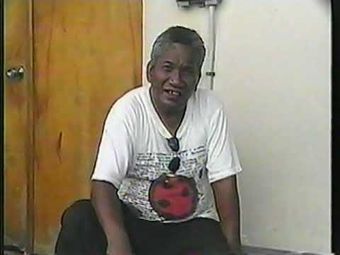Mañ 'Red pandanus fruit'
- Description:
- Pandanus (Pandanus conoideus) is an endemic plant of New Guinea. When referred to in Tok Pisin, people from the Sepik call it karuka, while the Highlanders use the term marita. Its oily fruit is an important part of the Awiakay diet, eaten either with sago pancakes or with sweet potato, when the latter is available. As a source of oil it is even more important for the Meakambut. Pandanus fruit cluster, which has a tapered cylindrical shape, is up to 1m long and can weigh up to 10kg. It is green when unripe, and turns red to dark-red, or yellow to yellow-orange (depending on the type of the pandanus) when ripe. The fruit cluster consists of many fruits, attached to an inner pith, which can be either white or yellow. The fruits consist of a seed and the surrounding pulp. The Awiakay and Meakambut eat both, the pith and the fruits. As the length of the fruiting season depends on the temperature (and therefore on the altitude), at lower altitudes, fruits are available more or less throughout the year (Walter and Sam 2002: 210). The Awiakay and the Meakambut always check pandanus trees on their way to bush camps, while hunting, etc., and when they notice that a fruit cluster is poking out of the leaves [the fruit has developed and become visible], they know it is ready to be harvested. When ripe, the fruit cluster is harvested from the tree, often with a help of a long stick, and brought to a camp or to the village, where it is cut into smaller pieces, to fit into a pot. It is then boiled in water, which softens the hard fruit cluster enough so that the fruits can be extracted from the pith. The pith, which becomes soft when boiled, is eaten by itself, but is not considered ‘real food’. People bite into the pieces from which the fruits have been scraped, and partly swallow them, partly suck them out, and the fibrous core is chewed out and discarded. The oily fruits, however, are the most desirable part of pandanus. They softened during cooking, so the oily pulp can now be removed from the seeds. This is done by pouring cold water over the fruits and grinding and mixing them with hand. The person who does it (among Awiakay and Meakambut it can be either a man or a woman, but in other parts of PNG this work can be gender-specific. Bonnemère (Walter and Sam 2002: 211) reports that among the Ankave this is exclusively men’s job) then puts the remaining seeds in the mouth, sucks off the remaining pulp, and spits them out. The so prepared pandanus sauce (called karuka in the Sepik and marita in the Highlands variety of Tok Pisin) is very rich and oily, and usually eaten with sago pancakes or sweet potato. Its intense red colour dyes one’s faeces, and when eating pandanus sauce, the Awiakay often joke with the kids: “enmen pawinay” ‘your poo will be red’. As dogs often eat the seeds that people spit out after sucking off the pulp, as well as any leftover sauce and sago, we often see that dogs’ excrements are red and full of undigested seeds a day after people ate pandanus. Excessive consumption of pandanus sauce can cause diarrhoea. Pandanus oil has a strong pigment, and it is hard to hide that one has eaten it. In the best case scenario one ends up with bright orange-red lips and tongue (see Plate 10). If the ripe fruit cluster has not been harvested, it goes into ‘over-ripe stage’: the bright red grains start to darken and falling off the core. As the tangled aerial prop roots of pandanus trees bear a resemblance to tangled strings, the Awiakay closely associate pandanus with string figures in general, to the point that some Awiakay suggest that string figures are played when people eat pandanus fruit (see Hoenigman, forthcom.). At altitudes below 1000m, however (which is most of Awiakay land apart from their highest mountains), the fruiting season almost never stops. This string figure represents the three stages in the ‘life’ of a pandanus fruit. In the first stage the string figure-maker makes the fruit cluster. As she proceeds with the figure, she explains how the fruit is ripening. The second stage represents a ripe fruit. From now on, a reverse process starts taking place, as the figure is being undone. This represents the ripe fruits gradually falling off the cluster until the core is left bare. Many Awiakay say that mañ ‘red pandanus’ is the most difficult figure to make, because of all the twisting it involves. It was the only Awiakay figure for which I could not describe the entire process of making – I never managed to get beyond the ‘green fruit’. Images: 02, 03, 04: Darja Munbaŋgoapik making a string figure called mañ ‘red pandanus’, representing three stages of its fruit: 02: unripe fruit; 03: the ripening of the fruit; 04: the over-ripe fruit falls off the fruit cluster, leaving an empty core 05: mañ ‘the red pandanus’ 06: wakoñ ‘the yellow pandanus’ 07: making red pandanus sauce by mixing the boiled fruits with water Hoenigman, Darja. Forthcoming. Talking about strings: The language of string figure-making in a Sepik society, Papua New Guinea. Language Documentation & Conservation Journal. Walter, A. and C. Sam. 2002. Fruits of Oceania. Canberra: Australian Centre for International Agricultural research (ACIAR). pp. 210-211 https://aciar.gov.au/node/8516 (accessed 23 June 2020) . Language as given: Awiakay. You can access this item at the PARADISEC website. You will need to sign up or sign in first.
- Format:
- MovingImage
- Collections:
- PARADISEC Catalog
- Contributors:
- Darja Hoenigman
- Content partner:
- PARADISEC
- Availability:
- Not specified
-
Copyright status: All rights reservedFind out more about what you are able to do with this itemThis item is all rights reserved, with means you'll have to get permission from PARADISEC before using it. For more information, please see our use and reuse page.More informationPARADISEC has this to say about the rights status of this item:
Open (subject to agreeing to PDSC access conditions)
What can I do with this item?Non-infringing useNZ copyright law does not prevent every use of a copyright work, and this item may be hosted by an international institute or organisation. You should consider what you can and cannot do with a copyright work.No sharingYou may not copy and/or share this item with others without further permission. This includes posting it on your blog, using it in a presentation, or any other public use.No modifyingYou are not allowed to adapt or remix this item into any other works.No commercial useYou may not use this item commercially.
Related items
Welcome and warm Pasifik greetings
The information on this site has been gathered from our content partners.
The names, terms, and labels that we present on the site may contain images or voices of deceased persons and may also reflect the bias, norms, and perspective of the period of time in which they were created. We accept that these may not be appropriate today.
If you have any concerns or questions about an item, please contact us.

